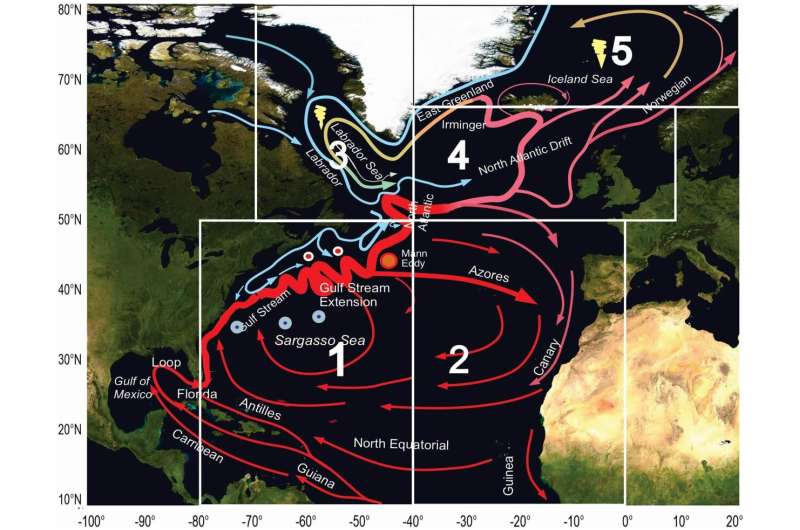This article has been reviewed according to Science X's editorial process and policies. Editors have highlighted the following attributes while ensuring the content's credibility:
fact-checked
peer-reviewed publication
trusted source
proofread
Study documents slowing of Atlantic currents

While scientists have observed oceans heating up for decades and theorized that their rising temperatures weaken global currents, a new study led by a University of Maryland researcher documents for the first time a significant slowing of a crucial ocean current system that plays a role in regulating Earth's climate.
Published recently in Frontiers in Marine Science, the paper led by Earth System Science Interdisciplinary Center (ESSIC) scientist Alexey Mishonov examined decades of data on the Atlantic Meridional Overturning Circulation (AMOC) found in the National Oceanic and Atmospheric Administration's (NOAA) World Ocean Atlas.
Mishonov and co-authors Dan Seidov and James Reagan from NOAA discovered that the current system's flow remained stable and consistent from 1955 to 1994. However, in the mid-1990s, AMOC strength began to decline and the current began to move slower, which the scientists attribute to the continued warming of the ocean's surface and the accompanying changes in the salinity of its upper layers.
AMOC, which includes the Gulf Stream, carries warm water toward higher latitudes, releasing heat into the atmosphere and bringing cold waters to the tropics. This forms a continuous loop that redistributes heat across the ocean.
"If AMOC slows down, the heat exchange will be reduced, which in turn will affect the climate, causing hot areas to get hotter and cold areas to get colder," said Mishonov. This could lead to global climate changes, sea level rise, impact on marine ecosystems and other climate feedbacks.
A similar, but highly exaggerated and fictionalized dynamic powered the plot of the 2004 disaster blockbuster "The Day After Tomorrow," in which a flow of fresh water from melting glaciers led to the sudden collapse of North Atlantic Ocean currents, leading to outlandish effects like global superstorms and the sudden appearance of glaciers across much of the northern hemisphere.
"Of course, most climate scientists do not share these Hollywood fantasies, and no one inside scientific communities believes that anything remotely similar can happen," Mishonov said of the film. "However, most do believe that substantial slowing of AMOC might result in significant climate change that cannot be foreseen and predicted. Therefore, increased interest in AMOC functionality is fully warranted."
Mishonov and co-authors believe that the key to understanding the ocean climate trajectory is identifying how the North Atlantic climate responds to ongoing surface warming over decadal timespans.
The researchers used World Ocean Atlas data covering 1955–2017 as well as climate reanalysis data on decadal wind stress and sea surface height fields from UMD's Simple Ocean Data Assimilation project to determine fingerprints of the North Atlantic's circulation and AMOC's dynamics.
The authors found that although the entire North Atlantic is systematically warming, the climate trajectories in its different subregions reveal radically different characteristics of regional decadal variability, reflecting diverse climate patterns. For example, while the temperature has gradually increased from 1955 to 2017, it dropped in the more northern Atlantic from 1955 to 1994, then rose from 1995 to 2017. Similar patterns are also visible in salinity and density.
This variation in climate characteristics indicates that the current situation may not predict what the future may hold, including whether AMOC's slowdown will persist, accelerate or diminish in the next decade. However, the paper suggests that scenarios involving the slowdown or collapse of AMOC cannot be dismissed. Next, the authors plan to explore other regions of the global ocean to look for similar patterns in long-term temperature and salinity variability.
More information: Alexey Mishonov et al, Revisiting the multidecadal variability of North Atlantic Ocean circulation and climate, Frontiers in Marine Science (2024). DOI: 10.3389/fmars.2024.1345426
Journal information: Frontiers in Marine Science
Provided by University of Maryland




















